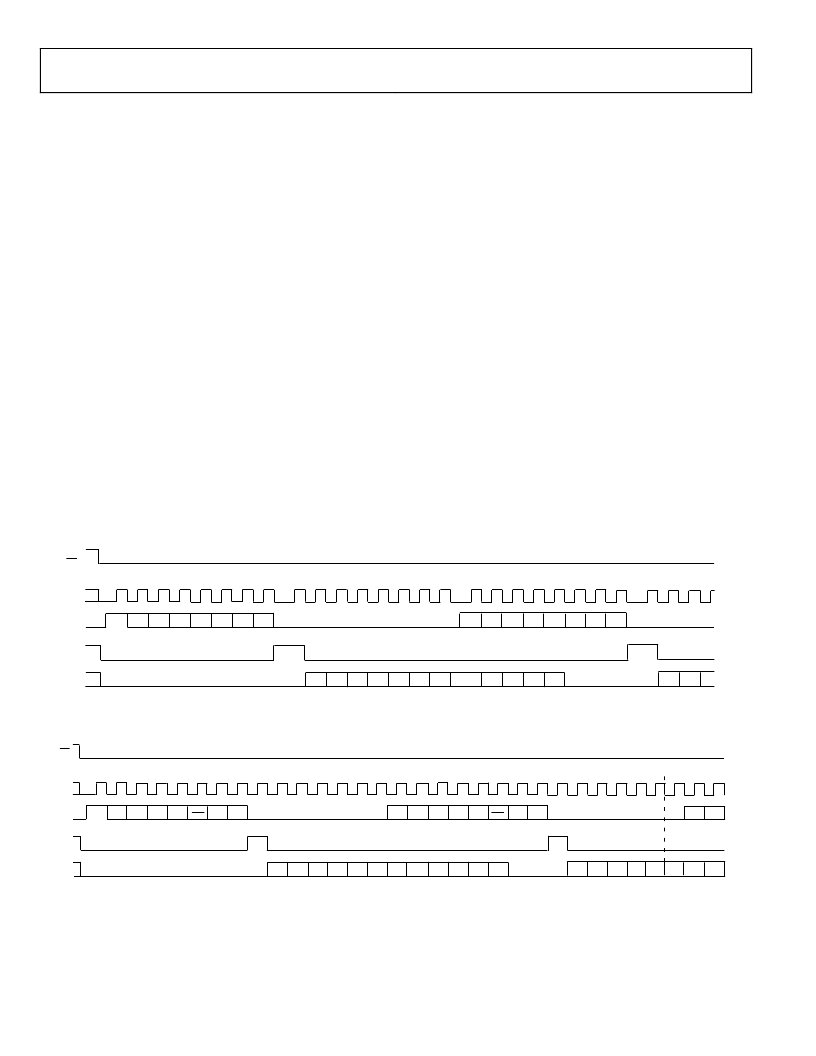- 您現(xiàn)在的位置:買賣IC網(wǎng) > PDF目錄373922 > AD7873ACP (ANALOG DEVICES INC) Touch Screen Digitizer PDF資料下載
參數(shù)資料
| 型號(hào): | AD7873ACP |
| 廠商: | ANALOG DEVICES INC |
| 元件分類: | 消費(fèi)家電 |
| 英文描述: | Touch Screen Digitizer |
| 中文描述: | SPECIALTY CONSUMER CIRCUIT, QCC16 |
| 封裝: | 4 X 4 MM, MO-220VGGC, LFCSP-16 |
| 文件頁數(shù): | 22/28頁 |
| 文件大小: | 657K |
| 代理商: | AD7873ACP |
第1頁第2頁第3頁第4頁第5頁第6頁第7頁第8頁第9頁第10頁第11頁第12頁第13頁第14頁第15頁第16頁第17頁第18頁第19頁第20頁第21頁當(dāng)前第22頁第23頁第24頁第25頁第26頁第27頁第28頁

AD7873
16 Clocks per Cycle
The control bits for the next conversion can be overlapped with
the current conversion to allow for a conversion every 16 DCLK
cycles, as shown in Figure 38. This timing diagram also allows
the possibility of communication with other serial peripherals
between each byte (eight DCLK) transfer between the processor
and the converter. However, the conversion must complete
within a short enough time frame to avoid capacitive droop
effects that could distort the conversion result. It should also be
noted that the AD7873 is fully powered while other serial
communications are taking place between byte transfers.
15 Clocks per Cycle
Figure 39 shows the fastest way to clock the AD7873. This
scheme does not work with most microcontrollers or DSPs
because they are not capable of generating a 15 clock cycle per
serial transfer. However, some DSPs allow the number of clocks
per cycle to be programmed. This method could also be used
with FPGAs (field programmable gate arrays) or ASICs (appli-
cation specific integrated circuits). As in the 16 clocks per cycle
case, the control bits for the next conversion are overlapped
with the current conversion to allow a conversion every 15
DCLK cycles using 12 DCLKs to perform the conversion and 3
DCLKs to acquire the analog input. This effectively increases
the throughput rate of the AD7873 beyond that used for the
specifications that are tested using 16 DCLKs per cycle, and
DCLK = 2 MHz.
Rev. D | Page 22 of 28
8-Bit Conversion
The AD7873 can be set up to operate in an 8-bit mode rather
than a 12-bit mode by setting the MODE bit in the control
register to 1. This mode allows a faster throughput rate to be
achieved, assuming 8-bit resolution is sufficient. When using 8-
bit mode, a conversion is complete four clock cycles earlier than
in 12-bit mode. This could be used with serial interfaces that
provide 12 clock transfers, or two conversions could be completed
with three eight-clock transfers. The throughput rate increases
by 25% as a result of the shorter conversion cycle, but the
conversion itself can occur at a faster clock rate because the
internal settling time of the AD7873 is not as critical, because
settling to eight bits is all that is required. The clock rate can be
as much as 50% faster. The faster clock rate and fewer clock
cycles combine to provide double the conversion rate.
0
CS
DCLK
DIN
BUSY
DOUT
1
S
S
11
10
9
8
7
6
5
4
3
2
1
0
11
10
9
1
1
1
8
8
8
CONTROL BITS
CONTROL BITS
Figure 38. Conversion Timing, 16 DCLKS per Cycle, 8-Bit Bus Interface. No DCLK delay required with dedicated serial port.
0
CS
DCLK
DIN
BUSY
DOUT
S
A2
PD1 PD0
A1
A0
MODEDFR
MODEDFR
1
11
10
9
8
7
6
5
4
3
2
1
0
11
10
9
8
7
6
5
4
15
1
15
1
S
A2
S
A2
A1
PD1 PD0
A0
Figure 39. Conversion Timing, 15 DCLKS per Cycle, Maximum Throughput Rate
相關(guān)PDF資料 |
PDF描述 |
|---|---|
| AD7873ACPZ | Touch Screen Digitizer |
| AD7873ACPZ3 | 10-Bit, 60 MSPS ADC SE/Diff, Int/Ext Ref., program. i/p range w/Pwrdown, comp. to ADS822/4/5/6/8 28-SSOP |
| AD7873ARQ | 10-Bit, 60 MSPS ADC SE/Diff, Int/Ext Ref., program. i/p range w/Pwrdown, comp. to ADS822/4/5/6/8 28-SSOP |
| AD7873ARU | Touch Screen Digitizer |
| AD7873ARUZ | Touch Screen Digitizer |
相關(guān)代理商/技術(shù)參數(shù) |
參數(shù)描述 |
|---|---|
| AD7873ACP-REEL | 制造商:Analog Devices 功能描述:TOUCH SCREEN DIGITIZER |
| AD7873ACP-REEL7 | 制造商:Analog Devices 功能描述:TOUCH SCREEN DIGITIZER |
| AD7873ACPZ | 功能描述:IC ADC 12BIT TOUCHSCREEN 16LFCSP RoHS:是 類別:集成電路 (IC) >> 數(shù)據(jù)采集 - 觸摸屏控制器 系列:- 標(biāo)準(zhǔn)包裝:96 系列:- 類型:- 觸摸面板接口:- 輸入數(shù)/鍵:- 分辨率(位):- 評(píng)估套件:* 數(shù)據(jù)接口:- 數(shù)據(jù)速率/采樣率 (SPS,BPS):- 電壓基準(zhǔn):- 電源電壓:- 電流 - 電源:- 工作溫度:- 安裝類型:表面貼裝 封裝/外殼:16-TSSOP(0.173",4.40mm 寬) 供應(yīng)商設(shè)備封裝:16-TSSOP 包裝:帶卷 (TR) |
| AD7873ACPZ3 | 制造商:AD 制造商全稱:Analog Devices 功能描述:Touch Screen Digitizer |
| AD7873ACPZ-REEL | 功能描述:IC ADC 12BIT TOUCHSCREEN 16LFCSP RoHS:是 類別:集成電路 (IC) >> 數(shù)據(jù)采集 - 觸摸屏控制器 系列:- 標(biāo)準(zhǔn)包裝:96 系列:- 類型:- 觸摸面板接口:- 輸入數(shù)/鍵:- 分辨率(位):- 評(píng)估套件:* 數(shù)據(jù)接口:- 數(shù)據(jù)速率/采樣率 (SPS,BPS):- 電壓基準(zhǔn):- 電源電壓:- 電流 - 電源:- 工作溫度:- 安裝類型:表面貼裝 封裝/外殼:16-TSSOP(0.173",4.40mm 寬) 供應(yīng)商設(shè)備封裝:16-TSSOP 包裝:帶卷 (TR) |
發(fā)布緊急采購,3分鐘左右您將得到回復(fù)。